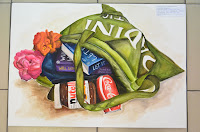**************************************
Preparatory period
You should select one starting point from this paper and start to develop your ideas. You may discuss your choice of starting point with your teacher at the beginning of the preparatory period for initial advice on materials and processes to explore. After that you must carry out your own research, planning and investigation of ideas to develop your own personal response.
In addition to the work you produce during the supervised test, you should submit up to two A2 sheets of supporting studies. You may use both sides of the paper if you wish.
There is no restriction on the size and scale of the work produced during the preparatory period but all work must be submitted on A2 sheets of paper. Work that is larger than A2, fragile or three-dimensional must be photographed, printed and mounted on an A2 sheet. You may work on a smaller scale if you prefer.
You may begin preparing your supporting studies as soon as you receive this paper and continue until the start of the supervised test. The supporting studies are your reference material, which will inform your work during the test.
Your supporting studies should show how you have developed your ideas and attempted different outcomes during the preparatory period. Remember that you have a limited time to produce your supporting studies and develop your ideas for your final outcome before the test.
You must bring your supporting studies to the start of the test so you can refer to them during the test. You must not add to or edit your supporting studies once the test begins. The centre will keep your supporting studies and final outcome secure for the whole test period.
All sources must be clearly and correctly referenced and you must identify sources that are not your own.
Supervised test
The supervised test will take place under examination conditions and will be split into a maximum of three sessions over no more than two weeks.
You should select and organise your supporting studies to support the final outcome that you produce during the test. You are not permitted to have access to the internet during the test.
Your supporting studies must be submitted with the final outcome and all work must be clearly labelled. Write your name, candidate number, centre number and the number of your chosen starting point on the labels provided and attach to the top right-hand corner of each sheet of paper.
The supporting studies and final outcome will be marked together against all the assessment criteria out of a total of 100 marks.
Assessment criteria
Your work will be assessed against the following criteria, which test your ability to:
- record ideas, observations and insights relevant to intentions as work progresses. You can do this by:
– recording ideas from first-hand studies such as your own drawings and photographs, as well as from secondary imagery
– understanding the importance of continually evaluating your work.
- explore and select appropriate resources, media, materials, techniques and processes.
You can do this by:
– exploring methods to develop themes and ideas throughout the preparatory period
– trying to find more appropriate ways to communicate your ideas.
- develop ideas through investigation, demonstrating critical understanding. You can do this by:
– understanding the importance of the context
– developing your ability to clearly show the differences between your ideas and the ideas of others
– carrying out in-depth research into artists, designers and cultural influences to help develop your ideas where appropriate.
- present a personal and coherent response that realises intentions and demonstrates an understanding of visual language. You can do this by:
– planning and producing a personal outcome which expresses what you want to communicate
– understanding the principles and conventions of visual language.
***********************************
Choose one
1. Rush hour
2. Construction
3. Reading by lamplight
4. Laboratory equipment
5. Growth
All the best!
































